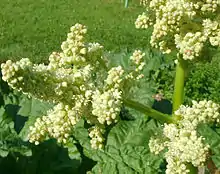Rheum rhaponticum
Rheum rhaponticum, the false rhubarb, rhapontic rhubarb or rhapontic, is a plant species in the genus Rheum found in the wild.[2] It is the only Rheum species found only in Europe, and is now restricted to the Rila mountain range in south-western Bulgaria.[1][3][4] It was introduced to other countries in Europe.[3] It is considered to be one of the parents of the modern culinary rhubarb.[5]
| False rhubarb | |
|---|---|
 | |
| Scientific classification | |
| Kingdom: | Plantae |
| Clade: | Tracheophytes |
| Clade: | Angiosperms |
| Clade: | Eudicots |
| Order: | Caryophyllales |
| Family: | Polygonaceae |
| Genus: | Rheum |
| Species: | R. rhaponticum |
| Binomial name | |
| Rheum rhaponticum | |
| Synonyms[1] | |
| |
Description
Rheum rhaponticum is a robust perennial herbaceous plant growing from a woody rhizome. It has large, undivided leaves, with succulent petioles (stalks). The blade of the leaf is up to 50 cm long, and is wider than its length. The leaves are heart-shaped at the base with five prominent nerves. The petioles are concave above and convex below, with about 10 ridges. The flowers are borne in a panicle and are light greenish-yellow in colour. The fruits have membrane-like wings and are about 5 mm long on pedicels (stems) of the same length.[4]
Karyotypy
In 1928, Jaretzky found R. rhaponticum to have 2n = 44 chromosomes,[6] however, a study of the wild Bulgarian population in 1989 revealed a chromosome number of 2n = 22.[4]
Taxonomy
Rheum rhaponticum was first described by Carl Linnaeus in 1753.[7] Linnaeus knew the plant only from cultivated specimens grown at Uppsala in Sweden and in the Netherlands. These were derived from plants grown the early 17th century in the Padua botanic garden, collected by a former student of the botanic garden, Francisco Crasso, in what was then known as Thrace. Plants from the Rila mountain range have been compared to those in Linnaeus's herbarium and are considered to be the same species. The name Rheum rhaponticum has also been applied in a broad sense to culinary rhubarb.[4]
History
The word rha ponticum, Latin for 'rha from Pontus' (Pontus corresponds to the northern coast of Anatolia), was first mentioned by Dioscorides, who says that this is the name the Romans used for a valued medicinal root imported from the east. Dioscorides also mentions the root is most similar to that of Centaurea.[8]
Throughout most of the Middle Ages and early modern era Europeans were unaware of the source for these roots, which had become known as rheum barbarum (among many other names, including the Persian raved). Botanists such as Leonhart Fuchs (in 1542) and Rembert Dodoens (in 1554) identified a species of thistle in the family Asteraceae, Rhaponticum scariosum, as the source of the root, thus this plant was used to produce an inferior rhubarb.[9]
R. rhaponticum was the first rhubarb plant ever to be seen by Europeans, but it took some time before Europeans accepted that rhubarb was harvested from Rheum.
Chemistry
Hyperoside, the 3-O-galactoside of quercetin, can be found in R. rhaponticum, where it may serve as a UV blocker found in the bracts. It also contains the hydroxystilbenes rhaponticin and desoxyrhaponticin.[10]
References
- "Rheum rhaponticum". Plants of the World Online. Retrieved 20 January 2019.
- "Rheum rhaponticum L." Integrated Taxonomic Information System. Retrieved November 11, 2013.
- "Rheum rhaponticum". Red Book of Bulgaria, Volume I. Retrieved 20 January 2019.
- Libert, Bo & Englund, Roger (1989). "Present Distribution and Ecology of Rheum rhaponticum (Polygonaceae)". Willdenowia. 19 (1): 91–98. JSTOR 3996925.
- Tanhuanpää, Pirjo; Suojala-Ahlfors, Terhi & Hartikainen, Merja (2019), "Genetic diversity of Finnish home garden rhubarbs (Rheum spp.) assessed by simple sequence repeat markers", Genetic Resources and Crop Evolution, 66 (1): 17–25, doi:10.1007/s10722-018-0692-8
- Ruirui, Liu; Wang, Ailan; Tian, Xinmin; Wang, Dongshi; Liu, Jianquan (2010). "Uniformity of karyotypes in Rheum (Polygonaceae), a species-rich genus in the Qinghai-Tibetan Plateau and adjacent regions". Caryologia Firenze. 63 (1): 82–90. doi:10.1080/00087114.2010.10589711. Retrieved 24 March 2019.
- "Plant Name Details for Rheum rhaponticum L". The International Plant Names Index. Retrieved 2019-03-10.
- Osbaldeston, Tess Anne; Wood, RPA (2000). Dioscorides - De Materia Medica. Johannesburg: Ibidis Press. pp. 364, 367. ISBN 0-620-23435-0.
- "Capitel 10 Deel 3 Cruijdeboeck 1554". Plantaardigheden (in Dutch). 18 February 2015. Retrieved 16 March 2019.
- Vollmer, Gunter; Papke, Anja; Zierau, Oliver (2010). "Treatment of menopausal symptoms by an extract from the roots of rhapontic rhubarb: The role of estrogen receptors". Chinese Medicine. 5: 7. doi:10.1186/1749-8546-5-7. PMC 2837008. PMID 20170496.
External links
 Data related to Rheum rhaponticum at Wikispecies
Data related to Rheum rhaponticum at Wikispecies Media related to Rheum rhaponticum at Wikimedia Commons
Media related to Rheum rhaponticum at Wikimedia Commons